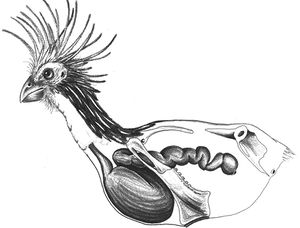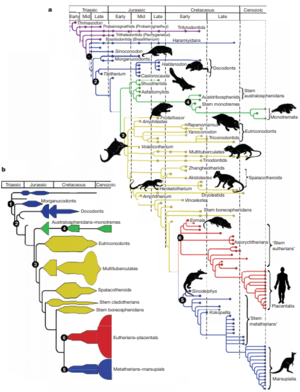Co-Evolution of Microbes and the Mammalian Gut: Difference between revisions
No edit summary |
No edit summary |
||
| Line 6: | Line 6: | ||
<br>By Joanna van Dyk<br> | <br>By Joanna van Dyk<br> | ||
<br> | <br> Microbes likely had commensal relationships with the ancestors of mammals, long before they evolved to give birth to live young or obtained many of the traits that charcterize the class of vertabrates today. <ref name=Ley2008a>Ley, Ruth E et al. “Worlds within worlds: evolution of the vertebrate gut microbiota.” Nature reviews. Microbiology vol. 6,10 (2008): 776-88. doi:10.1038/nrmicro1978 </ref> Today, the microbiota of mammalian guts show similarities between species from similar ancestry, but also between those that have similar diets. <ref name=Ley2008a>Ley, Ruth E et al. “Worlds within worlds: evolution of the vertebrate gut microbiota.” Nature reviews. Microbiology vol. 6,10 (2008): 776-88. doi:10.1038/nrmicro1978 </ref> The earliest mammals were carnivorous, and without microbes, they would have not been able take advantage of the diverse array of nutrients offered by the plant kingdom. This allowed them to fill many of the ecological niches left when the dinosaurs became extinct 65 million years ago.<ref name=Yong2016>Yong, Ed. I contain multitudes: The microbes within us and a grander view of life. Random House, 2016.</ref> Mammalian gut microbiomes have evolved to aid their hosts in the digestion of plant toxins that would otherwise completely disable them, such as Nordihydroguaiaretic acid. This chemical would cause desert woodrats (<i>N. lepida</i>) to develop kidney cysts and liver damage if its gut bacteria did not digest it for them. <ref name=Kohl2014>Kohl, Kevin D., et al. "Gut microbes of mammalian herbivores facilitate intake of plant toxins." Ecology Letters 17.10 (2014): 1238-1246.</ref> Unlike other vertebrates, mammals are in the unique position of being able to inherit their microbiomes from their mothers through the vaginal canal and through breast milk. This may enable the preservation of microbial lineages over time<ref name=Kelly2011> Kelley, Scott T., and Susanne Dobler. "Comparative analysis of microbial diversity in Longitarsus flea beetles (Coleoptera: Chrysomelidae)." Genetica 139.5 (2011): 541-550.</ref> | ||
<br> | <br>In this page we adress the questions: How specialized are the microbe lineages associated with mammalian guts? And, when a mammal adopts a diffferent diet, how much does its gut microbiome resemble the microbiomes of its close relatives?<br> | ||
<br> | |||
[[Image:mammalphylogeny.png|thumb|300px|right| Phylogeny and diversification of major mammal groups <ref name=Luo2007>Luo, Zhe-Xi. "Transformation and diversification in early mammal evolution." Nature 450.7172 (2007): 1011-1019.</ref>]] | [[Image:mammalphylogeny.png|thumb|300px|right| Phylogeny and diversification of major mammal groups <ref name=Luo2007>Luo, Zhe-Xi. "Transformation and diversification in early mammal evolution." Nature 450.7172 (2007): 1011-1019.</ref>]] | ||
Revision as of 21:35, 21 April 2020
Introduction


By Joanna van Dyk
Microbes likely had commensal relationships with the ancestors of mammals, long before they evolved to give birth to live young or obtained many of the traits that charcterize the class of vertabrates today. [3] Today, the microbiota of mammalian guts show similarities between species from similar ancestry, but also between those that have similar diets. [3] The earliest mammals were carnivorous, and without microbes, they would have not been able take advantage of the diverse array of nutrients offered by the plant kingdom. This allowed them to fill many of the ecological niches left when the dinosaurs became extinct 65 million years ago.[4] Mammalian gut microbiomes have evolved to aid their hosts in the digestion of plant toxins that would otherwise completely disable them, such as Nordihydroguaiaretic acid. This chemical would cause desert woodrats (N. lepida) to develop kidney cysts and liver damage if its gut bacteria did not digest it for them. [5] Unlike other vertebrates, mammals are in the unique position of being able to inherit their microbiomes from their mothers through the vaginal canal and through breast milk. This may enable the preservation of microbial lineages over time[6]
In this page we adress the questions: How specialized are the microbe lineages associated with mammalian guts? And, when a mammal adopts a diffferent diet, how much does its gut microbiome resemble the microbiomes of its close relatives?

Early Evolution
Include some current research, with at least one figure showing data.
Coloniation of the Gut
Include some current research, with at least one figure showing data.
Hidgut and Foregut Fermentation
Detoxification of Plant Secondary Compounds
Include some current research, with at least one figure showing data.
Conclusion
References
- ↑ Grajal, A., and S. D. Strahl. "A bird with the guts to eat leaves." Natural History 8 (1991): 48.
- ↑ Stevens, C. Edward, and Ian D. Hume. "Contributions of microbes in vertebrate gastrointestinal tract to production and conservation of nutrients." Physiological reviews 78.2 (1998): 393-427.
- ↑ 3.0 3.1 Ley, Ruth E et al. “Worlds within worlds: evolution of the vertebrate gut microbiota.” Nature reviews. Microbiology vol. 6,10 (2008): 776-88. doi:10.1038/nrmicro1978
- ↑ Yong, Ed. I contain multitudes: The microbes within us and a grander view of life. Random House, 2016.
- ↑ Kohl, Kevin D., et al. "Gut microbes of mammalian herbivores facilitate intake of plant toxins." Ecology Letters 17.10 (2014): 1238-1246.
- ↑ Kelley, Scott T., and Susanne Dobler. "Comparative analysis of microbial diversity in Longitarsus flea beetles (Coleoptera: Chrysomelidae)." Genetica 139.5 (2011): 541-550.
- ↑ Luo, Zhe-Xi. "Transformation and diversification in early mammal evolution." Nature 450.7172 (2007): 1011-1019.
Authored for BIOL 238 Microbiology, taught by Joan Slonczewski, 2018, Kenyon College.
